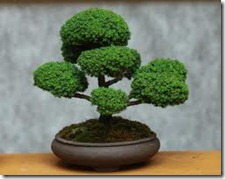 Over the centuries the artists of bonsai have developed hundreds of unique styles. But within this complexity there are a few that form the basis of most of the variations of bonsai trees.
Over the centuries the artists of bonsai have developed hundreds of unique styles. But within this complexity there are a few that form the basis of most of the variations of bonsai trees.
Chokkan (Formal Upright)
The simplest, but still exquisitely beautiful, is the chokkan or formal upright style of bonsai trees. Though still a miniature, this style most resembles the full grown tree. The form is erect and partly symmetrical, roughly classic Christmas-tree shaped, but sometimes with a rounded crown.
Branches are approximately horizontal and the lowest pair are frequently trained to point toward the viewer, with a third pointing away at a level between the two in front.
Though the chokkan is more regular than other styles of bonsai trees, it need not be planted directly in the center of the pot. Visual variety can be achieved by planting a third from one end, either left or right as you face the tree.
Smaller branches nearer the base should be trimmed off, and others should be balanced around the trunk. The first branch starts at about one-third up the total height of the trunk.
Remember that to achieve the right result, you must have a good beginning. That starts with selection of the proper species of bonsai trees. A tree that, left unmodified, would naturally grow straight is the best choice.
One of the less difficult styles to achieve – no bonsai tree is easy to train – it nevertheless can exhibit significant variations. Using different species, such as Larch, or Pine, or Spruce can result in distinct looks.
Moyogi (Informal Upright)
The moyogi shares many similarities with the chokkan, but vertical and horizontal regularity is altered. The moyogi is less even in appearance, but to the bonsai trees enthusiast no less beautiful than its more symmetrical brother.
Branches are trained in the same manner, but the top is modified to bend slightly toward the viewer. The trunk may also be slanted, but not curved, slightly.
Slanting can be achieved by training, or by selecting types of bonsai trees with a natural tendency to veer from the vertical. Check similar instances of a species from the top looking down to detect deviations from the vertical.
To achieve a slant that tilts away from the viewer, plant or train bonsai trees in the pot so that the roots move forward, to the front of the pot. This can be encouraged by wiring and selective watering that favors the front of the container. As the trunk slants backward the roots will point ahead naturally as the tree attempts to maximize its support.
Moyogi, like the chokkan bonsai trees, generally have full crowns with branches that start about one-third up the trunk. Deciduous species, such as the Japanese Maple, or beeches, are naturally well-suited to this style. Some fruit trees, such as Pomegranate or Crab Apple, may also serve the purpose.
All indoor bonsai trees, regardless of style, require much patience and care over many years in order to achieve health and longevity. But these two styles are the least difficult to attain and may serve as a good beginning for the novice.

Deprecated: strpos(): Passing null to parameter #1 ($haystack) of type string is deprecated in /home/agriviek8Qv/agriviet.net/public_html/wp-includes/comment-template.php on line 2522